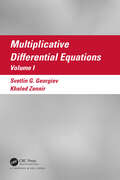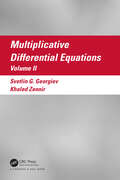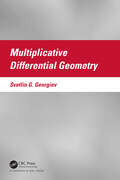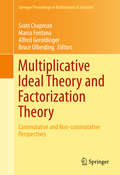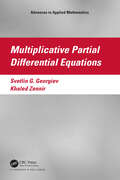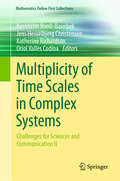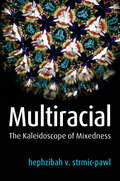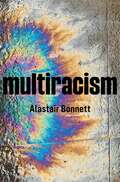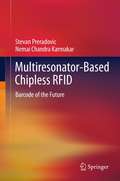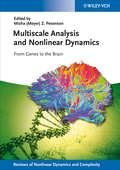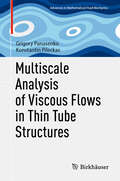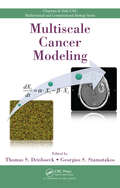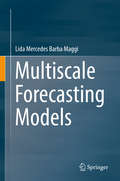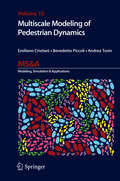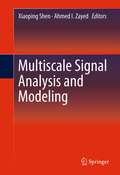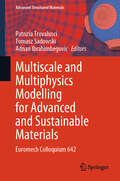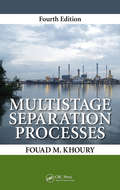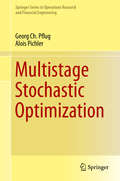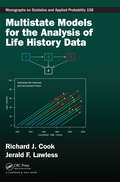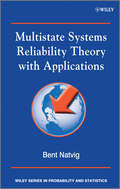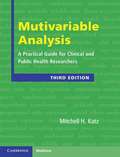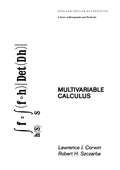- Table View
- List View
Multiplicative Differential Equations: Volume I
by Svetlin G. Georgiev Khaled ZennirMultiplicative Differential Equations: Volume I is the first part of a comprehensive approach to the subject. It continues a series of books written by the authors on multiplicative, geometric approaches to key mathematical topics. This volume begins with a basic introduction to multiplicative differential equations and then moves on to first- and second-order equations, as well as the question of existence and uniqueness of solutions. Each chapter ends with a section of practical problems. The book is accessible to graduate students and researchers in mathematics, physics, engineering and biology.
Multiplicative Differential Equations: Volume II
by Svetlin Georgiev Khaled ZennirMultiplicative Differential Equations: Volume II is the second part of a comprehensive approach to the subject. It continues a series of books written by the authors on multiplicative, geometric approaches to key mathematical topics. This volume is devoted to the theory of multiplicative differential systems. The asymptotic behavior of the solutions of such systems is studied. Stability theory for multiplicative linear and nonlinear systems is introduced and boundary value problems for second-order multiplicative linear and nonlinear equations are explored. The authors also present first-order multiplicative partial differential equations. Each chapter ends with a section of practical problems. The text is accessible to graduate students and researchers in mathematics, physics, engineering and biology.
Multiplicative Differential Geometry
by Svetlin G. GeorgievThis book introduces multiplicative Frenet curves. We define multiplicative tangent, multiplicative normal, and multiplicative normal plane for a multiplicative Frenet curve. We investigate the local behaviours of a multiplicative parameterized curve around multiplicative biregular points, define multiplicative Bertrand curves and investigate some of their properties. A multiplicative rigid motion is introduced. The book is addressed to instructors and graduate students, and also specialists in geometry, mathematical physics, differential equations, engineering, and specialists in applied sciences. The book is suitable as a textbook for graduate and under-graduate level courses in geometry and analysis. Many examples and problems are included. The author introduces the main conceptions for multiplicative surfaces: multiplicative first fundamental form, the main multiplicative rules for differentiations on multiplicative surfaces, and the main multiplicative regularity conditions for multiplicative surfaces. An investigation of the main classes of multiplicative surfaces and second fundamental forms for multiplicative surfaces is also employed. Multiplicative differential forms and their properties, multiplicative manifolds, multiplicative Einstein manifolds and their properties, are investigated as well. Many unique applications in mathematical physics, classical geometry, economic theory, and theory of time scale calculus are offered.
Multiplicative Ideal Theory and Factorization Theory
by Marco Fontana Scott Chapman Alfred Geroldinger Bruce OlberdingThis book consists of both expository and research articles solicited from speakers at the conference entitled "Arithmetic and Ideal Theory of Rings and Semigroups," held September 22-26, 2014 at the University of Graz, Graz, Austria. It reflects recent trends in multiplicative ideal theory and factorization theory, and brings together for the first time in one volume both commutative and non-commutative perspectives on these areas, which have their roots in number theory, commutative algebra, and algebraic geometry. Topics discussed include topological aspects in ring theory, Prüfer domains of integer-valued polynomials and their monadic submonoids, and semigroup algebras. It will be of interest to practitioners of mathematics and computer science, and researchers in multiplicative ideal theory, factorization theory, number theory, and algebraic geometry.
Multiplicative Partial Differential Equations (Advances in Applied Mathematics)
by Svetlin G. Georgiev Khaled ZennirMultiplicative Partial Differential Equations presents an introduction to the theory of multiplicative partial differential equations (MPDEs). It is suitable for all types of basic courses on MPDEs. The author’s aim is to present a clear and well-organized treatment of the concept behind the development of mathematics and solution techniques. The text material of this book is presented in a highly readable, mathematically solid format. Many practical problems are illustrated displaying a wide variety of solution techniques. Features Includes new classification and canonical forms of second-order MPDEs Proposes a new technique to solving the multiplicative wave equation such as the method of separation of variables and the energy method The proposed technique in the book can be used to give the basic properties of multiplicative elliptic problems, fundamental solutions, multiplicative integral representation of multiplicative harmonic functions, mean-value formulas, strong principle of maximum, multiplicative Poisson equation, multiplicative Green functions, method of separation of variables, and theorems of Liouville and Harnack
Multiplicity of Time Scales in Complex Systems: Challenges for Sciences and Communication I (Mathematics Online First Collections)
by Bernhelm Booß-Bavnbek Katherine Richardson Jens Hesselbjerg Christensen Oriol Vallès CodinaThis highly interdisciplinary volume brings together a carefully curated set of case studies examining complex systems with multiple time scales (MTS) across a variety of fields: materials science, epidemiology, cell physiology, mathematics, climatology, energy transition planning, ecology, economics, sociology, history, and cultural studies. The book addresses the vast diversity of interacting processes underlying the behaviour of different complex systems, highlighting the multiplicity of characteristic time scales that are a common feature of many and showcases a rich variety of methodologies across disciplinary boundaries. Self-organizing, out-of-equilibrium, ever-evolving systems are ubiquitous in the natural and social world. Examples include the climate, ecosystems, living cells, epidemics, the human brain, and many socio-economic systems across history. Their dynamical behaviour poses great challenges in the pressing context of the climate crisis, since they may involve nonlinearities, feedback loops, and the emergence of spatial-temporal patterns, portrayed by resilience or instability, plasticity or rigidity; bifurcations, thresholds and tipping points; burst-in excitation or slow relaxation, and worlds of other asymptotic behaviour, hysteresis, and resistance to change. Chapters can be read individually by the reader with special interest in such behaviours of particular complex systems or in specific disciplinary perspectives. Read together, however, the case studies, opinion pieces, and meta-studies on MTS systems presented and analysed here combine to give the reader insights that are more than the sum of the book’s individual chapters, as surprising similarities become apparent in seemingly disparate and unconnected systems. MTS systems call into question naïve perceptions of time and complexity, moving beyond conventional ways of description, analysis, understanding, modelling, numerical prediction, and prescription of the worldaround us. This edited collection presents new ways of forecasting, introduces new means of control, and – perhaps as the most demanding task – it singles out a sustainable description of an MTS system under observation, offering a more nuanced interpretation of the floods of quantitative data and images made available by high- and low-frequency measurement tools in our unprecedented era of information flows.
Multiplicity of Time Scales in Complex Systems: Challenges for Sciences and Communication II (Mathematics Online First Collections)
by Bernhelm Booß-Bavnbek Katherine Richardson Jens Hesselbjerg Christensen Oriol Vallès CodinaNote to the interested reader to have a look at the companion to this volume Challenges for Sciences and Communication I | ISBN: 978-3-031-28048-1.This highly interdisciplinary volume brings together a carefully curated set of case studies examining complex systems with multiple time scales (MTS) across a variety of fields: materials science, epidemiology, cell physiology, mathematics, climatology, energy transition planning, ecology, economics, sociology, history, and cultural studies. The book addresses the vast diversity of interacting processes underlying the behaviour of different complex systems, highlighting the multiplicity of characteristic time scales that are a common feature of many and showcases a rich variety of methodologies across disciplinary boundaries. Self-organizing, out-of-equilibrium, ever-evolving systems are ubiquitous in the natural and social world. Examples include the climate, ecosystems, living cells, epidemics, the human brain, and many socio-economic systems across history. Their dynamical behaviour poses great challenges in the pressing context of the climate crisis, since they may involve nonlinearities, feedback loops, and the emergence of spatial-temporal patterns, portrayed by resilience or instability, plasticity or rigidity; bifurcations, thresholds and tipping points; burst-in excitation or slow relaxation, and worlds of other asymptotic behaviour, hysteresis, and resistance to change. Chapters can be read individually by the reader with special interest in such behaviours of particular complex systems or in specific disciplinary perspectives. Read together, however, the case studies, opinion pieces, and meta-studies on MTS systems presented and analysed here combine to give the reader insights that are more than the sum of the book’s individual chapters, as surprising similarities become apparent in seemingly disparate and unconnected systems. MTS systems call into question naïve perceptionsof time and complexity, moving beyond conventional ways of description, analysis, understanding, modelling, numerical prediction, and prescription of the world around us. This edited collection presents new ways of forecasting, introduces new means of control, and – perhaps as the most demanding task – it singles out a sustainable description of an MTS system under observation, offering a more nuanced interpretation of the floods of quantitative data and images made available by high- and low-frequency measurement tools in our unprecedented era of information flows.
Multiracial: The Kaleidoscope of Mixedness
by hephzibah v. strmic-pawlThe year 2000 was the first time the US Census permitted respondents to choose more than one race. Although the US has long recognized that a &“mixed-race&” population exists, the contemporary &“multiracial population&” presents different questions and implications for today&’s diverse society. This book is the first overview to bring a systematic critical race lens to the scholarship on mixedness. Avoiding the common pitfall of conflating &“mixed&” with &“multiracial,&” the book reveals how identity forms and fluctuates such that people with mixed heritage may identify as mixed, monoracial, and/or multiracial throughout their lives. It analyzes the dynamic and various manifestations of mixedness, including at the global level, to reveal its complex impact on both the structural and individual levels. Multiracial critically examinestopics such as family dynamics and racial socialization, multiraciality in media and popular culture, and intersections of race, gender, class, and sexual orientation. Integrating diverse theories, qualitative research, and national-level data, this accessible and engaging book is essential for students of race and those looking to understand the new field of multiraciality.
Multiracism: Rethinking Racism in Global Context
by Alastair BonnettRacism is a world problem. From Morocco to China, Brazil to Indonesia, racism is being debated and contested. Multiracism broadens the horizon on this global challenge, showing that racism has a diverse history with multiple roots and routes. Drawing on examples of racism from across the globe, with particular focus on cases from Asia and Africa, Alastair Bonnett rethinks the origins of racism and the connections between racism and modernity. Arguing that plural modernities are interwoven with plural racisms, he explores the relationship of racism to history, religion, politics, and nationalism, as well as to anti-Black prejudice and discourses of whiteness. Empirically rich, with numerous in-depth case studies, Multiracism equips readers to understand racism in a multipolar world where power is no longer the sole possession of the West. It provides and provokes a new, international, and post-Western vision of racism for the twenty-first century.
Multiregional Clinical Trials for Simultaneous Global New Drug Development (Chapman & Hall/CRC Biostatistics Series)
by Joshua Chen Hui QuanIn a global clinical development strategy, multiregional clinical trials (MRCTs) are vital in the development of innovative medicines. Multiregional Clinical Trials for Simultaneous Global New Drug Development presents a comprehensive overview on the current status of conducting MRCTs in clinical development. International experts from academia, in
Multiresonator-Based Chipless RFID
by Stevan Preradovic Nemai Chandra KarmakarThis vital new resource offers engineers and researchers a window on important new technology that will supersede the barcode and is destined to change the face of logistics and product data handling. In the last two decades, radio-frequency identification has grown fast, with accelerated take-up of RFID into the mainstream through its adoption by key users such as Wal-Mart, K-Mart and the US Department of Defense. RFID has many potential applications due to its flexibility, capability to operate out of line of sight, and its high data-carrying capacity. Yet despite optimistic projections of a market worth $25 billion by 2018, potential users are concerned about costs and investment returns. Clearly demonstrating the need for a fully printable chipless RFID tag as well as a powerful and efficient reader to assimilate the tag's data, this book moves on to describe both. Introducing the general concepts in the field including technical data, it then describes how a chipless RFID tag can be made using a planar disc-loaded monopole antenna and an asymmetrical coupled spiral multi-resonator. The tag encodes data via the "spectral signature" technique and is now in its third-generation version with an ultra-wide band (UWB) reader operating at between 5 and 10.7GHz.
Multiscale Analysis and Nonlinear Dynamics
by Heinz Georg Schuster Misha Meyer PesensonSince modeling multiscale phenomena in systems biology and neuroscience is a highly interdisciplinarytask, the editor of the book invited experts in bio-engineering, chemistry, cardiology, neuroscience,computer science, and applied mathematics, to provide their perspectives. Each chapter is a window into the current state of the art in the areas of research discussed and the book is intended for advanced researchers interested in recent developments in these fields. While multiscaleanalysis is the major integrating theme of the book, its subtitle does not call for bridging thescales from genes to behavior, but rather stresses the unifying perspective offered by the conceptsreferred to in the title. It is believed that the interdisciplinary approach adopted here will be beneficial for all the above mentioned fields.
Multiscale Analysis of Viscous Flows in Thin Tube Structures (Advances in Mathematical Fluid Mechanics)
by Konstantin Pileckas Grigory PanasenkoThis book presents the analysis of viscous flows in thin tube structures, and develops a multi-scale method for modeling blood flow. For the reader’s convenience, the authors introduce all necessary notions and theorems from functional analysis and the classical theory of the Navier-Stokes equations. The problems of all asymptotic methods used in the book are explained as well, such as the dimension reduction and the boundary layer method. Through several numerical experiments, readers will discover that the proposed methods are more flexible than the theoretically predicted conditions. Multiscale Analysis of Viscous Flows in Thin Tube Structures will be a valuable resource for a wide range of readers, including applied mathematicians, specialists in bio-engineering, and biophysicists.
Multiscale Cancer Modeling (Chapman & Hall/CRC Mathematical Biology Series)
by Thomas S. Deisboeck Georgios S. StamatakosCancer is a complex disease process that spans multiple scales in space and time. Driven by cutting-edge mathematical and computational techniques, in silico biology provides powerful tools to investigate the mechanistic relationships of genes, cells, and tissues. It enables the creation of experimentally testable hypotheses, the integration of dat
Multiscale Forecasting Models
by Lida Mercedes Barba MaggiThis book presents two new decomposition methods to decompose a time series in intrinsic components of low and high frequencies. The methods are based on Singular Value Decomposition (SVD) of a Hankel matrix (HSVD). The proposed decomposition is used to improve the accuracy of linear and nonlinear auto-regressive models. Linear Auto-regressive models (AR, ARMA and ARIMA) and Auto-regressive Neural Networks (ANNs) have been found insufficient because of the highly complicated nature of some time series. Hybrid models are a recent solution to deal with non-stationary processes which combine pre-processing techniques with conventional forecasters, some pre-processing techniques broadly implemented are Singular Spectrum Analysis (SSA) and Stationary Wavelet Transform (SWT). Although the flexibility of SSA and SWT allows their usage in a wide range of forecast problems, there is a lack of standard methods to select their parameters. The proposed decomposition HSVD and Multilevel SVD are described in detail through time series coming from the transport and fishery sectors. Further, for comparison purposes, it is evaluated the forecast accuracy reached by SSA and SWT, both jointly with AR-based models and ANNs.
Multiscale Methods for Fredholm Integral Equations
by Zhongying Chen Charles A. Micchelli Yuesheng XuThe recent appearance of wavelets as a new computational tool in applied mathematics has given a new impetus to the field of numerical analysis of Fredholm integral equations. This book gives an account of the state of the art in the study of fast multiscale methods for solving these equations based on wavelets. The authors begin by introducing essential concepts and describing conventional numerical methods. They then develop fast algorithms and apply these to solving linear, nonlinear Fredholm integral equations of the second kind, ill-posed integral equations of the first kind and eigen-problems of compact integral operators. Theorems of functional analysis used throughout the book are summarised in the appendix. The book is an essential reference for practitioners wishing to use the new techniques. It may also be used as a text, with the first five chapters forming the basis of a one-semester course for advanced undergraduates or beginning graduates.
Multiscale Modeling of Pedestrian Dynamics
by Andrea Tosin Emiliano Cristiani Benedetto PiccoliThis book presents mathematical models and numerical simulations of crowd dynamics. The core topic is the development of a new multiscale paradigm, which bridges the microscopic and macroscopic scales taking the most from each of them for capturing the relevant clues of complexity of crowds. The background idea is indeed that most of the complex trends exhibited by crowds are due to an intrinsic interplay between individual and collective behaviors. The modeling approach promoted in this book pursues actively this intuition and profits from it for designing general mathematical structures susceptible of application also in fields different from the inspiring original one. The book considers also the two most traditional points of view: the microscopic one, in which pedestrians are tracked individually and the macroscopic one, in which pedestrians are assimilated to a continuum. Selected existing models are critically analyzed. The work is addressed to researchers and graduate students.
Multiscale Signal Analysis and Modeling
by Ahmed I. Zayed Xiaoping ShenMultiscale Signal Analysis and Modeling presents recent advances in multiscale analysis and modeling using wavelets and other systems. This book also presents applications in digital signal processing using sampling theory and techniques from various function spaces, filter design, feature extraction and classification, signal and image representation/transmission, coding, nonparametric statistical signal processing, and statistical learning theory.
Multiscale and Multiphysics Modelling for Advanced and Sustainable Materials: Euromech Colloquium 642 (Advanced Structured Materials #231)
by Patrizia Trovalusci Tomasz Sadowski Adnan IbrahimbegovicThis book offers the proceedings of Euromech colloquium 642, which wanted to provide a forum to present and debate several advanced computational, experimental, and analytical methods for studying the behaviour of complex materials and structures. The goal was to gather researchers (engineers, physicists, and mathematicians) specialized in multiscale material modelling for simulating the mechanics of solids and the physics of matter with the final aim of bridging the gap between solids and structural mechanics and material science in the modelling of “complex” materials. Both computational and experimental aspects play a central role, and talks have also focused on a broad range of aspects either related to the material modelling or the structural one. Various types of complex materials, made of very different constituents, are used nowadays in engineering practice: particle or fibrous composites; laminates; green composites with natural fillers and industrial or urban recyclable materials; nanomaterials; architecture material; in general complex multiphase materials with a complex internal structure including: porosity, reinforcement in the form of short fibres and particles of various properties, shapes, and sizes, filled in different media. It is widely recognized that important macroscopic properties such as the macroscopic stiffness and strength are governed by multiphysics processes (e.g. damage due to heat transfer or fluid penetration, crack propagation under thermal shock in ceramic/metallic matrix composites, etc.) which occur at one to several scales below the level of observation. A thorough understanding of how these processes influence the reduction of stiffness and strength is a key to the analysis of existing, and the design of improved, complex materials. The colloquium was centred on “Multiscale and Multiphysics Modeling of Complex Materials”, with attention to the constitutive aspects concerning complex materials, so defined for the presence of internal structure at different scales (nano/micro/meso) and nonlinear constitutive behaviour (plasticity, damage, fracture, etc.).
Multistage Separation Processes
by Fouad M. KhouryThe latest edition of a perennial bestseller, Multistage Separation Processes, Fourth Edition provides a clear and thorough presentation of the theoretical foundation, and understanding of the development, evaluation, design, and optimization steps of these processes, from both an academic and industrial perspective. The book's emphasis on starting
Multistage Stochastic Optimization
by Georg Ch. Pflug Alois PichlerMultistage stochastic optimization problems appear in many ways in finance, insurance, energy production and trading, logistics and transportation, among other areas. They describe decision situations under uncertainty and with a longer planning horizon. This book contains a comprehensive treatment of today's state of the art in multistage stochastic optimization. It covers the mathematical backgrounds of approximation theory as well as numerous practical algorithms and examples for the generation and handling of scenario trees. A special emphasis is put on estimation and bounding of the modeling error using novel distance concepts, on time consistency and the role of model ambiguity in the decision process. An extensive treatment of examples from electricity production, asset liability management and inventory control concludes the book.
Multistate Models for the Analysis of Life History Data (Chapman & Hall/CRC Monographs on Statistics and Applied Probability)
by Richard J Cook Jerald F. LawlessMultistate Models for the Analysis of Life History Data provides the first comprehensive treatment of multistate modeling and analysis, including parametric, nonparametric and semiparametric methods applicable to many types of life history data. Special models such as illness-death, competing risks and progressive processes are considered, as well as more complex models. The book provides both theoretical development and illustrations of analysis based on data from randomized trials and observational cohort studies in health research. <P><P>Features <li>Discusses a wide range of applications of multistate models <li>Presents methods for both continuously and intermittently observed life history processes <li>Gives a thorough discussion of conditionally independent censoring and observation processes <li>Discusses models with random effects and joint models for two or more multistate processes <li>Discusses and illustrates software for multistate analysis that is available in R <li>Target audience includes those engaged in research and applications involving multistate models <P><P>Richard Cook is Canada Research Chair in Statistical Methods for Health Research at the University of Waterloo. He has received the Gold Medal of the Statistical Society of Canada and is a Fellow of the American Statistical Association. He collaborates and consults widely on health research and has given many short courses. He and Dr. Lawless previously coauthored the influential book, The Statistical Analysis of Recurrent Events (Springer, 2007). <P><P>Jerald Lawless is Distinguished Professor Emeritus at the University of Waterloo. He is a Fellow of the Royal Society of Canada, a Gold Medal recipient of the Statistical Society of Canada and Fellow of the American Statistical Association. He is a past editor of Technometrics and has collaborated and consulted in numerous areas. He has presented many short courses, with Dr. Cook and individually. <P><P>"The authors of the book are internationally renowned experts in the field of multi-state modeling and have written an extremely clear and comprehensive book on the topic that covers many different aspects, from the fundamental theory to the practical side of analyzing data and interpreting results. The examples are well chosen to represent the most common types of multi-state processes that public health researchers could encounter. The inclusion of software code to illustrate how the models can be fit and interpreted is especially helpful to readers." (Mimi Kim, Albert Einstein College of Medicine)
Multistate Systems Reliability Theory with Applications
by Bent NatvigMost books in reliability theory are dealing with a description of component and system states as binary: functioning or failed. However, many systems are composed of multi-state components with different performance levels and several failure modes. There is a great need in a series of applications to have a more refined description of these states, for instance, the amount of power generated by an electrical power generation system or the amount of gas that can be delivered through an offshore gas pipeline network.This book provides a descriptive account of various types of multistate system, bound-for multistate systems, probabilistic modeling of monitoring and maintenance of multistate systems with components along with examples of applications.Key Features:Looks at modern multistate reliability theory with applications covering a refined description of components and system states.Presents new research, such as Bayesian assessment of system availabilities and measures of component importance.Complements the methodological description with two substantial case studies. Reliability engineers and students involved in the field of reliability, applied mathematics and probability theory will benefit from this book.
Multivariable Analysis
by Mitchell H. KatzNow in its third edition, this highly successful text has been fully revised and updated with expanded sections on cutting-edge techniques including Poisson regression, negative binomial regression, multinomial logistic regression and proportional odds regression. As before, it focuses on easy-to-follow explanations of complicated multivariable techniques. It is the perfect introduction for all clinical researchers. It describes how to perform and interpret multivariable analysis, using plain language rather than complex derivations and mathematical formulae. It focuses on the nuts and bolts of performing research, and prepares the reader to set up, perform and interpret multivariable models. Numerous tables, graphs and tips help to demystify the process of performing multivariable analysis. The text is illustrated with many up-to-date examples from the medical literature on how to use multivariable analysis in clinical practice and in research.
Multivariable Calculus (Pure and Applied Mathematics #64)
by Lawrence J. Corwin Robert J. Szczarba<p>Classroom-tested and lucidly written, Multivariable Calculus gives a thorough and rigorous treatment of differential and integral calculus of functions of several variables. Designed as a junior-level textbook for an advanced calculus course, this book covers a variety of notions,including continuity , differentiation, multiple integrals, line and surface integrals, differential forms, and infinite series. <p>Numerous exercises and examples throughout the book facilitate the student's understanding of important concepts. The level of rigor in this textbook is high; virtually every result is accompanied by a proof. To accommodate teachers' individual needs, the material is organized so that proofs can be deemphasized or even omitted. Linear algebra for n-dimensional Euclidean space is developed when required for the calculus; for example, linear transformations are discussed for the treatment of derivatives. <p>Featuring a detailed discussion of differential forms and Stokes' theorem, <i>Multivariable Calculusis</i> an excellent textbook for junior-level advanced calculus courses and it is also useful for sophomores who have a strong background in single-variable calculus. A two-year calculus sequence or a one-year honor calculus course is required for the most successful use of this textbook. Students will benefit enormously from this book's systematic approach to mathematical analysis, which will ultimately prepare them for more advanced topics in the field.</p>
